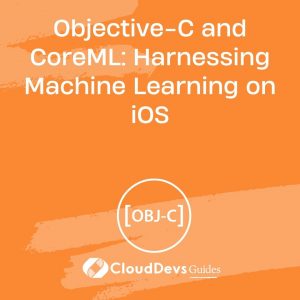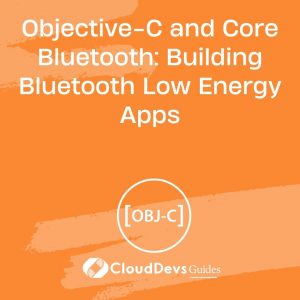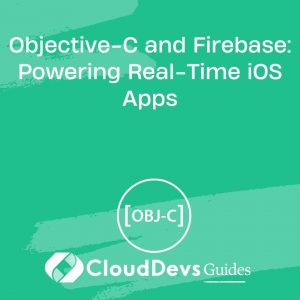Objective-C and CoreML: Harnessing Machine Learning on iOS
In the ever-evolving world of mobile app development, staying at the forefront of innovation is crucial. One of the most exciting advancements in this field is the integration of machine learning into iOS applications. With the advent of CoreML, Apple has made it easier than ever to harness the power of machine learning in your Objective-C-based iOS projects.
In this comprehensive guide, we will explore the fusion of Objective-C and CoreML, providing you with the knowledge and tools needed to incorporate machine learning features into your iOS apps. Whether you’re a seasoned iOS developer or just getting started, this journey into the world of Objective-C and CoreML will empower you to create smarter, more intuitive applications.
Table of Contents
1. Understanding CoreML: A Brief Overview
Before we dive into the integration of CoreML with Objective-C, let’s take a moment to understand what CoreML is and why it’s a game-changer for iOS development.
1.1. What is CoreML?
CoreML is a framework introduced by Apple, specifically designed for machine learning on iOS devices. It enables developers to integrate pre-trained machine learning models into their applications seamlessly. These models can perform a wide range of tasks, from image and text recognition to natural language processing and sentiment analysis.
1.2. Key Benefits of CoreML
- Performance: CoreML leverages the power of the device’s CPU and GPU, ensuring high-performance machine learning computations without the need for an internet connection.
- Privacy: With CoreML, data stays on the device, preserving user privacy and security.
- Ease of Use: Apple provides a wide selection of pre-trained models, making it easy for developers to get started without extensive machine learning expertise.
Now that we have a basic understanding of CoreML let’s explore how to integrate it into Objective-C projects.
2. Setting Up Your Objective-C Project
To begin harnessing the power of CoreML in your Objective-C project, you’ll need to set up your development environment correctly. Here’s a step-by-step guide to get you started:
Step 1: Create a New Xcode Project
If you haven’t already, launch Xcode and create a new iOS project. Ensure you select the “Single View App” template or any other template that suits your application’s needs.
Step 2: Import CoreML Framework
To use CoreML in your Objective-C project, you need to import the CoreML framework. Add the following line to your project’s bridging header:
objective #import <CoreML/CoreML.h>
Step 3: Add a Machine Learning Model
CoreML relies on machine learning models to make predictions. You can either create your own custom model or use one of the pre-trained models provided by Apple. For this guide, we’ll use a pre-trained model for image recognition.
Step 4: Convert the Model to a .mlmodel File
Apple’s CoreML tools allow you to convert machine learning models from various formats, such as TensorFlow or ONNX, to the .mlmodel format that CoreML understands. This can be done using the coremltools Python package.
Here’s an example of how to convert a model using coremltools:
python
import coremltools as ct
# Load your model (replace 'your_model.onnx' with your model file)
model = ct.models.MLModel('your_model.onnx')
# Convert the model to CoreML format
coreml_model = ct.converters.onnx.convert(model)
# Save the CoreML model to a file
coreml_model.save('YourModel.mlmodel')
Once you’ve converted your model, add the resulting .mlmodel file to your Xcode project.
Step 5: Code Integration
Now that you have your CoreML model in your Xcode project, it’s time to integrate it into your Objective-C code. Here’s a simple example of how to load and use a CoreML model for image recognition:
objective
#import <CoreML/CoreML.h>
#import <Vision/Vision.h>
- (void)performImageRecognition {
// Load your CoreML model (replace 'YourModel' with your model's name)
YourModel *model = [[YourModel alloc] init];
// Create a request for image analysis
VNCoreMLRequest *request = [[VNCoreMLRequest alloc] initWithModel:model error:nil];
// Load your image (replace 'image' with your UIImage)
VNImageRequestHandler *handler = [[VNImageRequestHandler alloc] initWithCGImage:image.CGImage options:@{}];
// Perform image analysis
[handler performRequests:@[request] error:nil];
// Process the results
NSArray<VNClassificationObservation *> *results = request.results;
for (VNClassificationObservation *observation in results) {
NSLog(@"%@: %f", observation.identifier, observation.confidence);
}
}
In this code snippet, we load the CoreML model, create a request for image analysis, and then process the results. This is just a basic example; you can adapt it to your specific use case.
3. Customizing Your Machine Learning Experience
One of the great strengths of CoreML is its flexibility. You can customize and fine-tune pre-trained models to suit your application’s needs. Here’s how you can do it:
3.1. Transfer Learning
Transfer learning is a technique that allows you to take a pre-trained model and fine-tune it on your specific dataset. This is especially useful when your dataset is different from the one the model was originally trained on.
To perform transfer learning in CoreML, follow these steps:
- Prepare your dataset: Collect and label the data relevant to your problem.
- Modify the final layers: Replace or fine-tune the output layers of the pre-trained model to match the number of classes or categories in your dataset.
- Train the model: Use your dataset to train the modified model.
- Convert the model: Once training is complete, convert the model to the .mlmodel format using the coremltools as shown earlier.
3.2. CoreML Tools for Model Customization
Apple provides a set of tools to help you customize your CoreML models. Here are a few worth mentioning:
- Create ML: This macOS app allows you to train custom machine learning models without writing code. It’s particularly handy for small to medium-sized datasets.
- Turicreate: Developed by Apple, Turicreate is a Python library that simplifies the creation of custom CoreML models. It’s a powerful tool for developers with some machine learning expertise.
4. Real-World Use Cases
Now that you have a grasp of how to integrate CoreML into your Objective-C project and customize your machine learning experience, let’s explore some real-world use cases where CoreML can shine.
4.1. Image Recognition
CoreML is exceptionally well-suited for image recognition tasks. You can integrate it into your app to identify objects, scenes, or even classify images based on their content. This is perfect for applications like:
- Retail Apps: Enhance the shopping experience by allowing users to snap pictures of products and receive detailed information.
- Social Media Apps: Implement image recognition for automatic tagging or content moderation.
4.2. Natural Language Processing
With CoreML, you can process and analyze text data for various purposes, such as sentiment analysis, language translation, or chatbots. Use cases include:
- Customer Support Chatbots: Create intelligent chatbots that understand and respond to user queries more effectively.
- Social Sentiment Analysis: Analyze user comments and posts to gauge public sentiment towards products, services, or topics.
4.3. Augmented Reality
CoreML can be integrated with ARKit to create compelling augmented reality experiences. You can recognize objects in the real world and overlay digital information seamlessly. Examples include:
- Navigation Apps: Recognize street signs, landmarks, or business logos to provide real-time navigation information.
- Educational Apps: Enhance learning experiences by overlaying educational content on objects in the physical world.
5. Pitfalls to Avoid
While CoreML offers immense potential, it’s essential to be aware of potential pitfalls when implementing machine learning in your app. Here are some common issues to watch out for:
5.1. Overcomplicating the Model
Start with a simple model and expand from there. Overly complex models can lead to performance issues and increased app size.
5.2. Neglecting Data Privacy
Respect user privacy by minimizing the amount of data your app sends to remote servers. Keep data processing on the device whenever possible.
5.3. Lack of Regular Updates
Machine learning models can become outdated. Ensure you have a plan to update your models as new data becomes available or as your app’s requirements change.
Conclusion
Objective-C and CoreML offer a powerful combination for iOS developers looking to integrate machine learning capabilities into their applications. With the ability to use pre-trained models, customize them for specific use cases, and apply machine learning to real-world scenarios, the possibilities are endless.
As you embark on your journey to harness the potential of Objective-C and CoreML, remember to start with the basics, experiment, and continuously improve your machine learning models. By doing so, you can create iOS apps that are smarter, more responsive, and more capable than ever before. So, dive in and let the power of machine learning elevate your iOS development game to new heights!
Table of Contents









